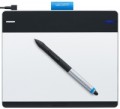Aspect ratio
The aspect ratio of the tablet working area (width to height). This parameter allows you to evaluate the overall proportions of the device: for example, the ratio of 4:3 gives an almost square shape of the work area, and in 16:9 models it is noticeably elongated in width.
Actually, "widescreen" aspect ratios —
16:9 and
16:10 — are now much more common than the classic
4:3. The
3:2 standard is also rare, although it is actually also a widescreen. This situation is due to the fact that, ideally, the aspect ratio of the monitor and tablet should be the same (otherwise, there may be a mismatch in the movement of the pen and the cursor on the screen, or part of the screen or tablet area will be unused). And the most popular nowadays are just monitors in 16:9 and 16:10 formats, the 4:3 standard is much less common, and 3:2 is extremely rare.
Touch input
The ability to work on a graphics tablet with your fingers — just like on the touch screen of a smartphone or tablet PC.
Touch input can be useful both during "non-working" hours (for example, if the tablet is used as a touchpad for a PC), and when drawing, to implement some specific techniques. At the same time, note that the accuracy of typing with a finger is much lower than when using a pen.
Max. reading height
The height within which pen movements above the working surface are recorded by the tablet electronics even in the absence of direct contact.
Many tablets allow you to work in a "non-contact" way — without directly touching the stylus to the work surface. Thanks to this, it is possible, for example, with a raised pen to bring the cursor in the graphics editor to the desired point and turn on the drawing mode by touching the tablet with the stylus. And the greater the maximum reading height, the more convenient it is to use this mode, the less demanding the tablet is for the accuracy of movements. In many modern models, this parameter exceeds 10 mm.
Response
A characteristic of a graphics tablet that determines how many times per second the tablet records the artist’s actions. The response rate is expressed in PPS (Points Per Second).
The higher the PPS value, the more responsive the surface is. If responsiveness is low, there is a possibility of getting jagged lines when working with the pen, and the stylus cursor may lag behind the movement of your hand. Devices with a response of
266 PPS or
more perform best, the “golden mean” is the range of values
230 – 233 PPS and
250 – 260 PPS, and in entry-level models the response can be
220 PPS or
less.
Eraser
The presence of an
eraser function in the pen — that is, the ability to use the pen not only for drawing a picture, but also for erasing it. Directly the role of the eraser is most often played by the second end of the pen, opposite to the “drawing” one; however, in some models, this function is implemented purely in software — by enabling a special pen mode.

